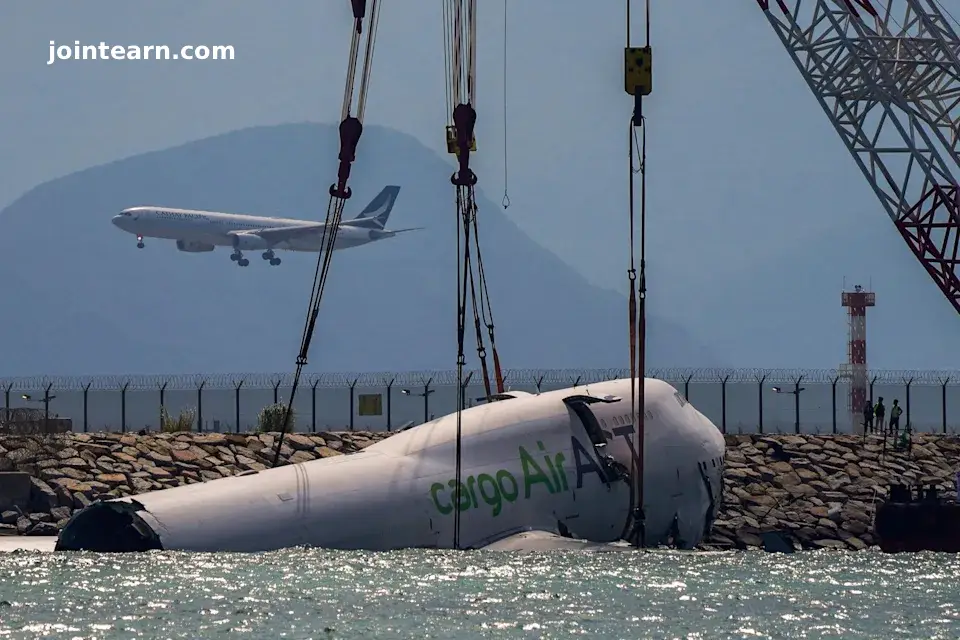
Salvage crews have retrieved the remains of a Boeing 747 cargo plane that plunged into the sea off Hong Kong International Airport, days after the crash that killed two ground workers.
Recovery Efforts Underway After Deadly Cargo Plane Crash
HONG KONG, October 26, 2025 — Authorities have successfully recovered the main wreckage of a Boeing 747 cargo plane that veered off a runway and plunged into the sea near Hong Kong International Airport last week. The tragic incident, which occurred on Monday, October 20, claimed the lives of two airport workers after the aircraft collided with a patrol vehicle.
The Turkey-based ACT Airlines jet had flown in from Dubai under a lease arrangement with Emirates Airlines when it skidded during landing, struck a patrol car, and crashed through a fence into coastal waters adjacent to the runway. The four crew members aboard the plane escaped unharmed.
On Sunday, heavy-lift cranes raised the front section of the fuselage from the seabed. Salvage engineers carefully maneuvered it into position before placing it onto a recovery vessel. The operation followed an underwater sonar survey to locate debris and assess seabed conditions, airport officials confirmed.
“The wreckage was lifted in stages to prevent further structural damage,” said a spokesperson for Hong Kong’s Air Accident Investigation Authority (AAIA). “The priority was both recovery and preservation of evidence.”
Data Recorders Retrieved and Analysis Underway
The aircraft’s tail section and several key components, including the flight data recorder (FDR) and cockpit voice recorder (CVR), were retrieved on Friday. These “black boxes” have been sent to a government laboratory for detailed analysis to help determine what caused the jet to veer off course during its final moments.
Preliminary findings from these devices are expected to form part of an initial report within one month, according to Hong Kong’s Transport and Logistics Bureau.
Representatives from the U.S. National Transportation Safety Board (NTSB), Turkey’s Transport Safety Investigation Center (TSIC), and Boeing are collaborating with local investigators to ensure an international standard of transparency and technical accuracy.
Crash Circumstances and Early Theories
During a news conference, Steven Yiu, Executive Director of Airport Operations at the Airport Authority Hong Kong (AAHK), said early assessments ruled out poor weather as a contributing factor.
“Weather and runway conditions met operational standards at the time,” Yiu stated. “Mechanical and human factors remain the primary focus of investigation.”
According to Yiu, the plane overshot its taxiway exit, breached security fencing, and collided with a patrol vehicle on a service road running parallel to the runway. The impact sent both the car and aircraft partially into the sea.
“Normally, a plane is not supposed to turn toward the sea,” Yiu added, noting that ground control had provided correct runway clearance and guidance before the incident.
Human Toll and Safety Review
Two airport maintenance workers inside the patrol vehicle were pronounced dead at the scene, sparking renewed scrutiny over airfield safety procedures. Their identities have not been released, pending notification of families.
In response, the Airport Authority announced a comprehensive safety review of vehicle movement protocols, airfield fencing, and runway approach guidance systems to prevent future tragedies.
A temporary closure of one runway was implemented during the recovery operation, briefly affecting flight schedules and cargo handling.
International Investigation and Industry Reactions
Boeing issued a statement expressing condolences to the victims’ families and pledging full cooperation with investigators.
“We are deeply saddened by the loss of life associated with this incident,” Boeing said. “Our technical experts are working closely with the AAIA, NTSB, and other authorities to support the ongoing investigation.”
Emirates Airlines also confirmed that the aircraft was operating under a wet-lease agreement with ACT Airlines and that its own fleet remains unaffected by the crash.
Aviation safety experts have called for a thorough analysis of flight control systems, landing procedures, and ground coordination protocols to determine whether human error, equipment malfunction, or miscommunication played a role.
Next Steps
Authorities expect to issue a preliminary accident report by late November 2025, followed by a comprehensive final report next year. Meanwhile, Hong Kong airport operations have returned to normal, though some safety enhancements are already being implemented.
The incident marks one of Hong Kong’s most serious runway accidents in recent years, reigniting discussions on aviation safety standards in Asia’s busiest air hubs.
Leave a Reply